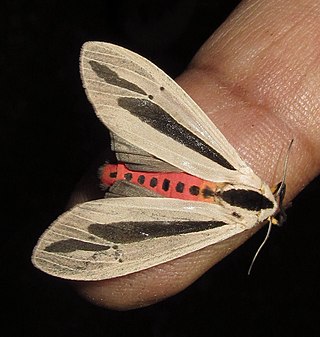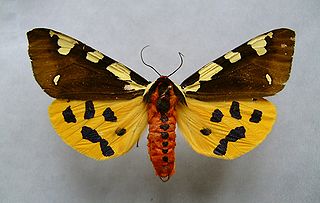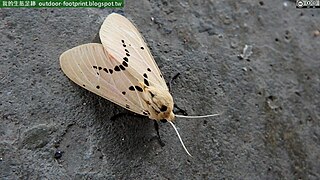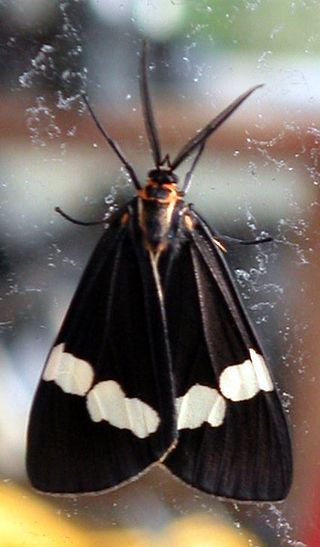
The Arctiinae are a large and diverse subfamily of moths with around 11,000 species found all over the world, including 6,000 neotropical species. This subfamily includes the groups commonly known as tiger moths, which usually have bright colours, footmen, which are usually much drabber, lichen moths, and wasp moths. Many species have "hairy" caterpillars that are popularly known as woolly bears or woolly worms. The scientific name Arctiinae refers to this hairiness. Some species within the Arctiinae have the word "tussock"' in their common names because they have been misidentified as members of the Lymantriinae subfamily based on the characteristics of the larvae.

Nyctemera is a genus of tiger moths in the family Erebidae first described by Jacob Hübner in 1820. The genus includes the species Nyctemera annulata and Nyctemera amica, which are closely related and are able to interbreed.

The Arctiini are a tribe of tiger moths in the family Erebidae.

Arctia is a genus of tiger moths in the family Erebidae. Therein, it belongs to the subtribe Arctiina in the tribe Arctiini in the subfamily Arctiinae. Species are well distributed throughout North America, Palearctic, India, and Sri Lanka.

Arctia menetriesii, the Menetries' tiger moth, is a species of tiger moth in the family Erebidae. It was first described by Eduard Friedrich Eversmann in 1846. It is found in Karelia, Oktyabrskoe, northeastern Kazakhstan, Altai Mountains, Sayan Mountains, Evenkia, Yakutia, the central Amur region, Primorsky Krai and central Sakhalin. It was believed to be extinct in Fennoscandia, but the species has been recently recorded in Finland.
Bucaea is a genus of tiger moths in the family Erebidae. The moths in the genus are found in Hindustan.
Calpenia is a genus of tiger moths in the family Erebidae. The genus was erected by Frederic Moore in 1872.

Creatonotos is a genus of tiger moths in the family Erebidae. The moths in the genus are found in the Afrotropics, South and East Asia, Sundaland and Australia.
Dolgoma is a genus of moths in the family Erebidae. The genus was erected by Frederic Moore in 1878.
Eudiaphora is a monotypic genus of tiger moths in the family Erebidae erected by Vladimir Viktorovitch Dubatolov in 1990. Its only species, Eudiaphora turensis, was first described by Nikolay Grigoryevich Erschoff in 1874. It is found in the mountains and deserts of Turkmenistan, Kazakhstan, Kyrgyzstan, Uzbekistan, Tajikistan, Afghanistan, western Mongolia, and China (Xinjiang).

Katha depressa, the buff footman, is a moth of the family Erebidae found in Asia and Europe. It was first described by Eugenius Johann Christoph Esper in 1787.

Wittia sororcula, the orange footman, is a species of moth in the family Erebidae. The species was first described by Johann Siegfried Hufnagel in 1766. It is found in Europe, Anatolia and further east across the Palearctic to southern Siberia and the Amur basin to China.

Arctia matronula is species of tiger moth in the family Erebidae. It was first described by Carl Linnaeus in his 1758 10th edition of Systema Naturae. It can be found in central and eastern Europe, Kazakhstan, southern Siberia, northern Mongolia, Amur Region, Primorye, Sakhalin, Kunashir, northern and northeastern China, Korea and Japan.
Satara is a genus of moths in the family Erebidae from Sulawesi and South India. The genus was erected by Francis Walker in 1865.

Spilarctia is a genus of moths in the family Erebidae. The genus was erected by Arthur Gardiner Butler in 1875.

Kishidaria is a genus of tiger moths in the family Erebidae. It is distributed in Asia from the Northeast India to southern China, Taiwan, and northern Vietnam.
Ebertarctia is a genus of tiger moths in the family Erebidae. These moths occur in Iran and Afghanistan.

The Nyctemerina are a subtribe of woolly bear moths in the family Erebidae.
Amerila eugenia is a moth of the subfamily Arctiinae. It was described by Johan Christian Fabricius in 1794. It is found in China, Pakistan (Karachi), central and southern India and Sri-Lanka.
Amerila rhodopa is a moth of the subfamily Arctiinae. It was described by Francis Walker in 1865. It is found in India.












